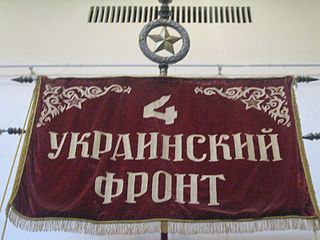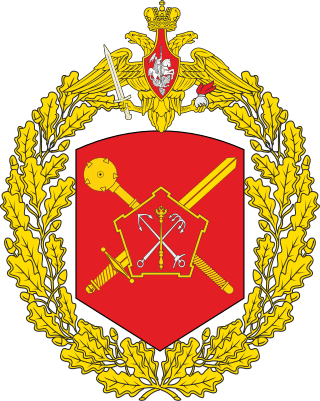Operational history
The Southwestern Front was on the main axis of attack by the German Army Group South during Operation Barbarossa. At the outbreak of war with Germany, the Front was commanded by Mikhail Kirponos and contained the Soviet 5th, 6th, 26th, and 12th Armies along the frontier. 16th and 19th Armies were in reserve behind the forward forces. These forces took part in the tank battles in western Ukraine and were surrounded and destroyed at the Battle of Uman and the Battle of Kiev (1941) in August and September 1941. Kirponos himself was killed during the Battle of Kiev.
The Front was immediately re-established with new forces. During the period of the Battle of Moscow it was under the command of Marshal Timoshenko, and included from north to south the 40th, 21st, 38th and 6th Armies. It was formally disbanded on July 12, 1942 and the forces transferred to the Stalingrad Front and Southern Front.
The Front was reformed from reserve armies on October 22, 1942. It was renamed the 3rd Ukrainian Front on October 20, 1943. 3rd Ukrainian Front's first operations were the Battle of the Dnieper and the Battle of Kiev (1943).
Southwestern Front on 22 June 1941
Composition Subordinate Front units directly under Commander of the Front: [1]
- 193rd Rifle Division
- 195th Rifle Division
- 200th Rifle Division
- 140th Rifle Division
- 146th Rifle Division
- 228th Rifle Division
- 190th Rifle Division
- 197th Rifle Division
- 199th Rifle Division
- 130th Rifle Division
- 169th Rifle Division
- 189th Rifle Division
- 1st Airborne Infantry Brigade
- 204th Airborne Infantry Brigade
- 211th Airborne Infantry Brigade
- 1st Kiev
- 3rd Latichov
- 5th Khorosten
- 7th Novogrudok–Volynsk
- 13th Shepetovka
- 15th Ostropol
- 17th Izaslav
- 5th Anti-Tank Brigade
- 205th Corps Artillery Regiment
- 207th Corps Artillery Regiment
- 368th Corps Artillery Regiment
- 457th Corps Artillery Regiment
- 458th Corps Artillery Regiment
- 507th Corps Artillery Regiment
- 543rd Corps Artillery Regiment
- 646th Corps Artillery Regiment
- 305th Cannon Artillery Regiment (RGK)
- 355th Cannon Artillery Regiment (RGK)
- 4th High Power Howitzer Regiment (RGK)
- 168th High Power Howitzer Regiment (RGK)
- 324th High Power Howitzer Regiment (RGK)
- 330th High Power Howitzer Regiment (RGk)
- 526th High Power Howitzer Regiment (RGK)
- 331st Howitzer Regiment (RGK)
- 376th Howitzer Regiment (RGK)
- 529th Howitzer Regiment (RGK)
- 538th Howitzer Regiment (RGK)
- 589th Howitzer Regiment (RGK)
- 34th Independent Special Artillery Division
- 245th Independent Special Artillery Division
- 315th Independent Special Artillery Division
- 316th Independent Special Artillery Division
- 263rd Independent Anti-Aircraft Artillery Division
- 3rd Air Defense Division
- 4th Air Defense Division
- 11th Air Defense Brigade
- Air Defense Brigade Regions:
- Stanislavov
- Rovno
- Zhitomir
- Tarnopol
- Vinnitsa
- Front Tank/Mechanized Troops
- 19th Mechanized Corps:
- 40th Tank Division
- 43rd Tank Division
- 213th Mechanized Division
- 21st Motorcycle Regiment
- 24th Mechanized Corps:
- 45th Tank Division
- 49th Tank Division
- 216th Mechanized Division
- 17th Motorcycle Regiment
- 1st Independent Armoured Car Division
- 44th Fighter Aviation Division
- 64th Fighter Aviation Division
- 19th Bomber Aviation Division
- 62nd Bomber Aviation Division
- 14th Mixed Aviation Division
- 15th Mixed Aviation Division
- 16th Mixed Aviation Division
- 17th Mixed Aviation Division
- 63rd Mixed Aviation Division
- 36th Fighter Aviation Division (PVO)
- 315th Air Reconnaissance Regiment
- 316th Air Reconnaissance Regiment
- 45th Engineer Regiment
- 1st Pontoon Bridge Regiment
The Southern Front was a front, a formation about the size of an army group of the Soviet Army during the Second World War. The Southern Front directed military operations during the Soviet occupation of Bessarabia and Northern Bukovina in 1940 and then was formed twice after the June 1941 invasion by Germany, codenamed Operation Barbarossa.

The 4th Ukrainian Front was the name of two distinct Red Army strategic army groups that fought on the Eastern Front in World War II.

The 3rd Ukrainian Front was a Front of the Soviet Red Army during World War II.
A mechanised corps was a Soviet armoured formation used prior to the beginning of World War II and reintroduced during the war, in 1942.

The 6th Combined Arms Army is a field army of the Red Army and the Soviet Army that was active with the Russian Ground Forces until 1998 and has been active since 2010 as the 6th Combined Arms Army.
The 18th Army of the Soviet Union's Red Army was formed on 21 June 1941 on the basis of HQ Kharkov Military District and armies of the Kiev Special Military District.

The 40th Army of the Soviet Ground Forces was an army-level command that participated in World War II from 1941 to 1945 and was reformed specifically for the Soviet–Afghan War from 1979 to circa 1990. The Army became the land forces arm of the Soviet occupational force in Afghanistan in the 1980s, the Limited Contingent of Soviet Forces in Afghanistan.
The 16th Army was a Soviet field army active from 1940 to 1945.
The 26th Army was a field army of the Soviet Union's Red Army, active from 1941.
The 19th Army was a field army of the Soviet Union's Red Army, formed in 1941 and active during the Second World War. The army was formed three times, although only two of its formations saw combat.

The 20th Army was a field army of the Red Army that fought on the Eastern Front during World War II.

The Soviet order of battle for Operation Uranus details the combat units of the Soviet forces that fought in Operation Uranus, the Soviet strategic counteroffensive that led to the encirclement of the German troops in Stalingrad. The order of battle lists units present on 19 November 1942, the day the operation began, from north to south.
The 8th Mechanized Corps, was a mechanized corps of the Soviet Ground Forces. It was destroyed in 1941 in the beginning of Operation Barbarossa.
The 9th Mechanized Corps was a mechanized corps of the Soviet Red Army, formed twice. It was first formed in November 1940 and disbanded in September 1941 after suffering heavy losses. The corps was formed again in August 1943 at Tula. The second formation fought with the 3rd Guards Tank Army. It participated in the Battle of the Dnieper, the Battle of Kiev (1943), the Dnieper–Carpathian Offensive, the Zhitomir–Berdichev Offensive, the Lvov–Sandomierz Offensive. the Battle of Berlin and the Prague Offensive. During the war the corps received the honorifics "Kiev" and "Zhitomir" and was awarded the Order of the Red Banner, the Order of Suvorov 2nd class, and the Order of Kutuzov 2nd class.
The 207th Rifle Division began its combat path under unusual circumstances. It was partly formed for the first time as a standard Red Army rifle division in the spring of 1941, before the German invasion, but was never completed. A second formation began in April 1942 and was completed on June 1, after which it was sent to the Stalingrad Front. Heavily depleted in counterattacks against the north flank of German Sixth Army, by November the survivors were reassigned and the division disbanded. The 207th was formed for a third time in June 1943, and fought its way through the central part of the Soviet-German front, ending the war in the heart of Berlin in the battle for the Reichstag. The division saw postwar service in the Group of Soviet Forces in Germany.
The 1st Tank Brigade was a Soviet tank brigade taking a part in World War II. The brigade was in the lines during 18 September 1941 to 16 February 1942.
The 1st Leningrad Tank Red Banner and Order of Suvorov Brigade was a tank brigade of the Red Army during World War II. The brigade was in the lines during 30 September 1941 to 8 December 1944.
The 215th Rifle Division was an infantry division of the Red Army during World War II that continued to serve in the Soviet Army during the early years of the Cold War. It was the successor to a motorized division of that same number that was destroyed during the Battle of Kiev in September 1941.
The 103rd Rocket Red Banner, Orders of Kutuzov and Bohdan Khmelnytskyi Brigade, is a tactical surface-to-surface missile formation of the Ground Forces of the Russian Federation. Its Military Unit Number is 47130. It is equipped with the 9K720 Iskander tactical ballistic missile.
This page is based on this
Wikipedia article Text is available under the
CC BY-SA 4.0 license; additional terms may apply.
Images, videos and audio are available under their respective licenses.





